-
 Bitcoin
Bitcoin $105,515.7682
-0.75% -
 Ethereum
Ethereum $2,550.8526
-3.88% -
 Tether USDt
Tether USDt $1.0004
0.02% -
 XRP
XRP $2.1386
-2.78% -
 BNB
BNB $653.0175
-0.31% -
 Solana
Solana $146.9461
-4.05% -
 USDC
USDC $0.9998
0.02% -
 Dogecoin
Dogecoin $0.1782
-2.00% -
 TRON
TRON $0.2708
-0.25% -
 Cardano
Cardano $0.6369
-3.90% -
 Hyperliquid
Hyperliquid $41.2211
0.21% -
 Sui
Sui $3.0463
-5.78% -
 Bitcoin Cash
Bitcoin Cash $438.0762
2.18% -
 Chainlink
Chainlink $13.2264
-5.73% -
 UNUS SED LEO
UNUS SED LEO $8.9649
0.98% -
 Stellar
Stellar $0.2593
-3.86% -
 Avalanche
Avalanche $19.1916
-5.96% -
 Toncoin
Toncoin $3.0052
-3.20% -
 Shiba Inu
Shiba Inu $0.0...01203
-1.86% -
 Hedera
Hedera $0.1572
-4.58% -
 Litecoin
Litecoin $85.5869
-1.34% -
 Polkadot
Polkadot $3.8083
-3.62% -
 Ethena USDe
Ethena USDe $1.0003
-0.02% -
 Monero
Monero $307.3843
-3.36% -
 Dai
Dai $0.9998
-0.02% -
 Bitget Token
Bitget Token $4.5079
-2.03% -
 Uniswap
Uniswap $7.4836
-2.67% -
 Pepe
Pepe $0.0...01116
-3.77% -
 Aave
Aave $282.2684
-3.42% -
 Pi
Pi $0.5680
-7.78%
What does it mean when the Bollinger Band price pierces the upper rail? What does it mean when it falls below the lower rail?
Bollinger Bands help traders spot overbought or oversold crypto conditions; piercing the upper rail may signal a correction, while falling below the lower rail could indicate a rebound.
Jun 09, 2025 at 05:42 am
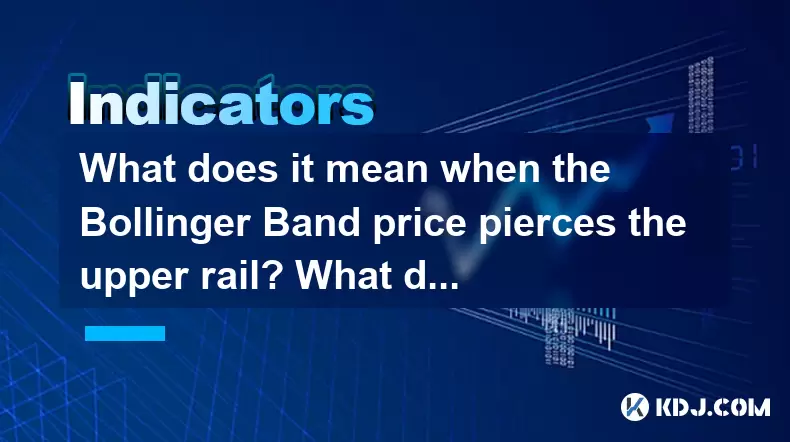
When analyzing cryptocurrency markets, technical indicators like the Bollinger Bands play a crucial role in understanding price movements and potential trends. Bollinger Bands consist of a middle band being a simple moving average (SMA), typically set at 20 periods, with an upper and lower band calculated based on standard deviations from the SMA. When the price of a cryptocurrency pierces the upper rail or falls below the lower rail of the Bollinger Bands, these movements can signal various market conditions. This article delves into what these movements signify, providing detailed insights into their implications for traders and investors.
Understanding Bollinger Bands
Before diving into the specifics of price movements relative to the Bollinger Bands, it's essential to have a clear understanding of what these bands represent. Bollinger Bands were developed by John Bollinger and are used to measure market volatility and identify potential overbought or oversold conditions. The middle band is typically a 20-day SMA, while the upper and lower bands are set two standard deviations away from the middle band.
The bands expand and contract based on market volatility; wider bands indicate higher volatility, and narrower bands suggest lower volatility. Traders use these bands to make informed decisions about entry and exit points in the market.
Price Piercing the Upper Rail
When the price of a cryptocurrency pierces the upper rail of the Bollinger Bands, it typically signals a few potential scenarios. This movement can indicate that the asset is entering an overbought condition. An overbought condition suggests that the price may have risen too far, too fast, and a correction might be imminent.
However, it's important to consider the context. If the price piercing the upper rail is accompanied by strong volume and positive market sentiment, it could also signal the beginning of a new bullish trend. Traders might interpret this as a sign to enter long positions, expecting further price increases.
Price Falling Below the Lower Rail
Conversely, when the price of a cryptocurrency falls below the lower rail of the Bollinger Bands, it often indicates that the asset is entering an oversold condition. An oversold condition suggests that the price may have fallen too far, too fast, and a rebound might be on the horizon. This can be an opportunity for traders to enter long positions, anticipating a price recovery.
Like the upper rail scenario, the context is crucial. If the price fall below the lower rail is accompanied by high volume and negative market sentiment, it might signal the beginning of a bearish trend. Traders might interpret this as a sign to enter short positions, expecting further price decreases.
Trading Strategies Based on Bollinger Bands
Understanding the implications of price movements relative to Bollinger Bands is essential, but applying this knowledge in trading strategies is where the real value lies. Here are some strategies traders might employ:
Mean Reversion Strategy: When the price pierces the upper rail, traders might anticipate a return to the middle band. They could enter short positions, expecting the price to revert to the mean. Conversely, when the price falls below the lower rail, traders might enter long positions, expecting a rebound to the mean.
Trend Following Strategy: If the price piercing the upper rail is part of a strong bullish trend, traders might enter long positions, expecting the trend to continue. Similarly, if the price falling below the lower rail is part of a strong bearish trend, traders might enter short positions, expecting the trend to persist.
Breakout Strategy: Traders might also look for breakouts above the upper rail or below the lower rail as signals to enter trades in the direction of the breakout. This strategy requires careful consideration of volume and other confirming indicators to avoid false breakouts.
Combining Bollinger Bands with Other Indicators
While Bollinger Bands can provide valuable insights into market conditions, they are most effective when used in conjunction with other technical indicators. Here are some common combinations:
Relative Strength Index (RSI): The RSI can help confirm overbought or oversold conditions indicated by Bollinger Bands. If the price pierces the upper rail and the RSI is above 70, it strengthens the case for an overbought condition. Conversely, if the price falls below the lower rail and the RSI is below 30, it strengthens the case for an oversold condition.
Moving Average Convergence Divergence (MACD): The MACD can help identify trend changes and momentum. If the price pierces the upper rail and the MACD shows bullish divergence, it might indicate a strong bullish trend. If the price falls below the lower rail and the MACD shows bearish divergence, it might indicate a strong bearish trend.
Volume: Volume is a critical factor in confirming price movements. If the price pierces the upper rail with high volume, it's more likely to be a valid breakout. Similarly, if the price falls below the lower rail with high volume, it's more likely to be a valid breakdown.
Practical Application in Trading
Applying Bollinger Bands in real-time trading requires a systematic approach. Here are some practical steps traders might follow:
Identify the Bollinger Bands: Plot the Bollinger Bands on your trading chart, using the default settings of a 20-day SMA and two standard deviations for the upper and lower bands.
Monitor Price Movements: Watch for the price to pierce the upper rail or fall below the lower rail. Use alerts to notify you of these events.
Analyze Context: Consider the broader market context, including volume, other technical indicators, and market sentiment. This will help you determine whether the price movement is part of a larger trend or a potential reversal.
Execute Trades: Based on your analysis, enter trades according to your chosen strategy. For example, if you're using a mean reversion strategy and the price pierces the upper rail, you might enter a short position, setting a stop-loss above the upper rail and a take-profit at the middle band.
Manage Risk: Always use appropriate risk management techniques, such as stop-loss orders and position sizing, to protect your capital.
Common Pitfalls and Misconceptions
While Bollinger Bands can be a powerful tool, there are some common pitfalls and misconceptions that traders should be aware of:
False Signals: Not every price movement relative to the Bollinger Bands is a valid signal. False breakouts and breakdowns can occur, especially in choppy markets. Always use confirming indicators and consider the broader market context.
Overreliance on a Single Indicator: Bollinger Bands should not be used in isolation. They are most effective when combined with other technical indicators and fundamental analysis.
Ignoring Market Context: The significance of price movements relative to Bollinger Bands can vary depending on the market context. Always consider the broader market environment when interpreting these movements.
Frequently Asked Questions
Q: Can Bollinger Bands predict cryptocurrency prices accurately?
A: Bollinger Bands are not designed to predict prices with absolute accuracy. They are a technical analysis tool that helps traders identify potential overbought or oversold conditions and market volatility. Their effectiveness depends on how they are used in conjunction with other indicators and market analysis.
Q: How often should I adjust the settings of Bollinger Bands for cryptocurrency trading?
A: The default settings of a 20-day SMA and two standard deviations are generally effective for most cryptocurrency trading scenarios. However, traders might adjust these settings based on the specific asset and timeframe they are trading. For more volatile assets, you might increase the number of standard deviations to reduce false signals.
Q: Are Bollinger Bands more effective for short-term or long-term trading in the cryptocurrency market?
A: Bollinger Bands can be used for both short-term and long-term trading, but they are often more effective for short-term trading due to their sensitivity to price volatility. For long-term trading, they can be used in conjunction with other trend-following indicators to identify longer-term trends and potential reversal points.
Q: Can Bollinger Bands be used for all cryptocurrencies, or are they more effective for certain types?
A: Bollinger Bands can be applied to all cryptocurrencies. However, their effectiveness might vary depending on the liquidity and volatility of the specific cryptocurrency. For highly volatile and less liquid cryptocurrencies, the bands might produce more false signals, requiring careful analysis and confirmation from other indicators.
Disclaimer:info@kdj.com
The information provided is not trading advice. kdj.com does not assume any responsibility for any investments made based on the information provided in this article. Cryptocurrencies are highly volatile and it is highly recommended that you invest with caution after thorough research!
If you believe that the content used on this website infringes your copyright, please contact us immediately (info@kdj.com) and we will delete it promptly.
- XRP Price Shows Signs of a Bullish Recovery, With Analysts Watching Levels for an Upside Breakout
- 2025-06-14 04:50:12
- XRP Price Shows Signs of a Bullish Recovery, as Analysts Watch Levels for an Upside Breakout
- 2025-06-14 04:50:12
- Leading Cryptocurrencies Dipped Despite Lower-Than-Expected Inflation and the New Trade Deal Announcement with China.
- 2025-06-14 04:45:12
- XRP Price Prediction: Can the Token Reach $73 This Cycle?
- 2025-06-14 04:40:12
- Bitcoin Hashrate Reaches All-Time High, Exceeding 943 EH/s
- 2025-06-14 04:40:12
- Bitcoin Hits Local ATH but Analysts Warn: Time to Sell and Watch Key Support
- 2025-06-14 04:35:13
Related knowledge

Is it an opportunity for the long positive line with large volume to break through the platform and then shrink back?
Jun 14,2025 at 04:42am
Understanding the Long Positive Line with Large VolumeIn technical analysis, a long positive line refers to a candlestick pattern where the closing price is significantly higher than the opening price, often indicating strong buying pressure. When this occurs alongside large volume, it suggests that market participants are actively involved in pushing t...
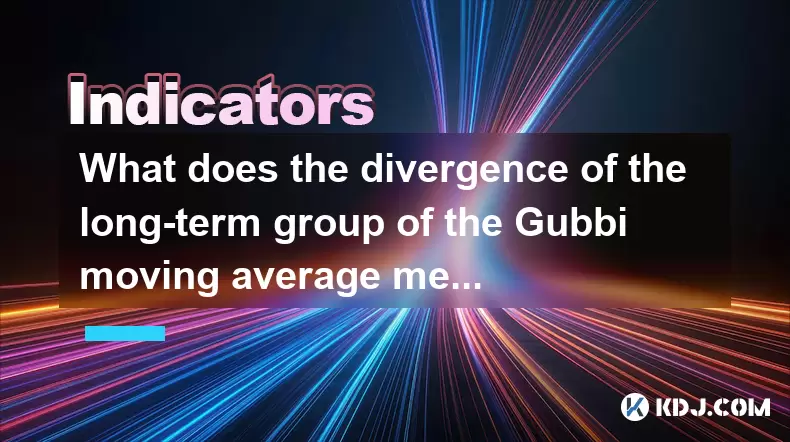
What does the divergence of the long-term group of the Gubbi moving average mean? How long can the trend last?
Jun 14,2025 at 02:56am
Understanding the Gubbi Moving AverageThe Gubbi moving average is a technical indicator used by traders in cryptocurrency markets to identify trends and potential reversals. Unlike traditional moving averages, the Gubbi variant incorporates unique calculations that emphasize price momentum and volatility adjustments. This makes it particularly useful fo...
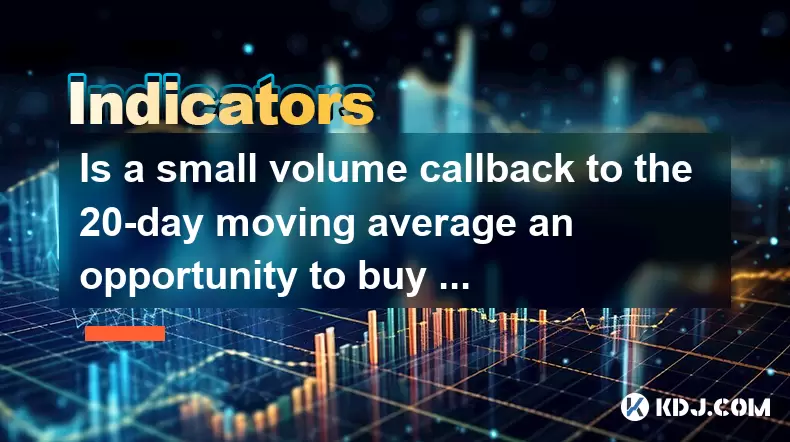
Is a small volume callback to the 20-day moving average an opportunity to buy low? What is the key to look at?
Jun 14,2025 at 02:28am
Understanding the 20-Day Moving Average in Cryptocurrency TradingIn cryptocurrency trading, the 20-day moving average (20DMA) is a commonly used technical indicator that helps traders assess the short-term trend of an asset. It calculates the average price of a cryptocurrency over the last 20 days and smooths out price volatility. When a coin experience...
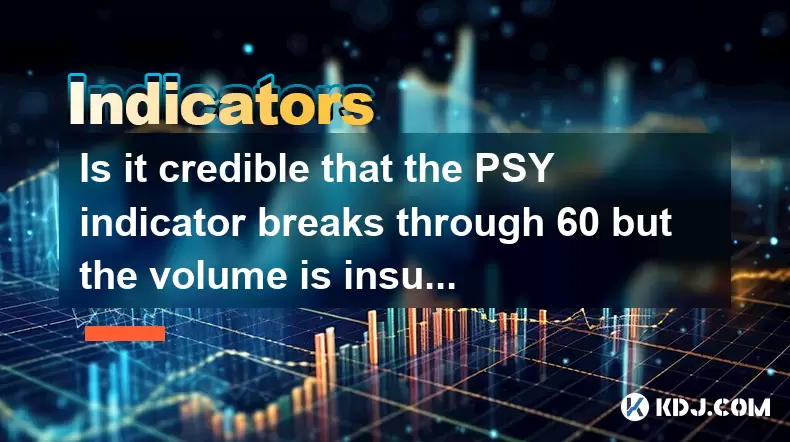
Is it credible that the PSY indicator breaks through 60 but the volume is insufficient?
Jun 14,2025 at 12:14am
Understanding the PSY Indicator in Cryptocurrency TradingThe Psychological Line (PSY) indicator is a momentum oscillator used primarily to measure the sentiment of traders and investors in financial markets, including the cryptocurrency space. It calculates the ratio of days where prices closed higher versus lower over a specified period, typically 12 o...
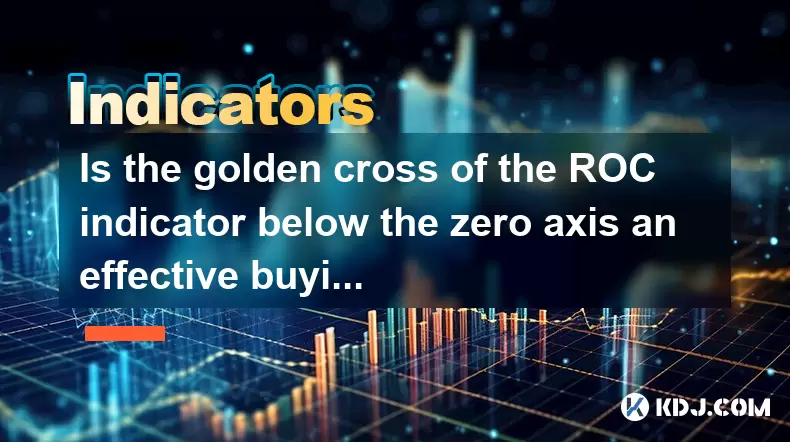
Is the golden cross of the ROC indicator below the zero axis an effective buying point?
Jun 14,2025 at 01:29am
Understanding the ROC Indicator and Its SignificanceThe Rate of Change (ROC) indicator is a momentum oscillator used in technical analysis to measure the percentage change in price between the current closing price and the closing price from a set number of periods ago. This tool helps traders assess the speed at which prices are changing, offering insi...
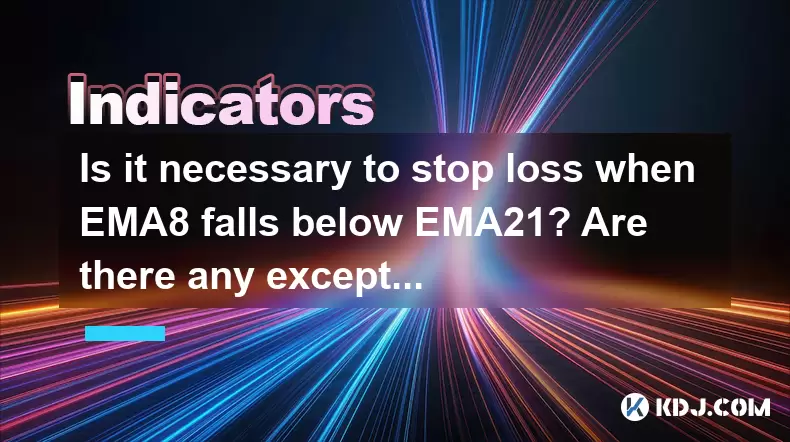
Is it necessary to stop loss when EMA8 falls below EMA21? Are there any exceptions?
Jun 14,2025 at 02:42am
Understanding EMA8 and EMA21 in Cryptocurrency TradingIn cryptocurrency trading, Exponential Moving Averages (EMAs) are widely used technical indicators to identify trends and potential reversal points. The EMA8 refers to the 8-period exponential moving average, while EMA21 is the 21-period EMA. These tools help traders make informed decisions by smooth...

Is it an opportunity for the long positive line with large volume to break through the platform and then shrink back?
Jun 14,2025 at 04:42am
Understanding the Long Positive Line with Large VolumeIn technical analysis, a long positive line refers to a candlestick pattern where the closing price is significantly higher than the opening price, often indicating strong buying pressure. When this occurs alongside large volume, it suggests that market participants are actively involved in pushing t...

What does the divergence of the long-term group of the Gubbi moving average mean? How long can the trend last?
Jun 14,2025 at 02:56am
Understanding the Gubbi Moving AverageThe Gubbi moving average is a technical indicator used by traders in cryptocurrency markets to identify trends and potential reversals. Unlike traditional moving averages, the Gubbi variant incorporates unique calculations that emphasize price momentum and volatility adjustments. This makes it particularly useful fo...

Is a small volume callback to the 20-day moving average an opportunity to buy low? What is the key to look at?
Jun 14,2025 at 02:28am
Understanding the 20-Day Moving Average in Cryptocurrency TradingIn cryptocurrency trading, the 20-day moving average (20DMA) is a commonly used technical indicator that helps traders assess the short-term trend of an asset. It calculates the average price of a cryptocurrency over the last 20 days and smooths out price volatility. When a coin experience...

Is it credible that the PSY indicator breaks through 60 but the volume is insufficient?
Jun 14,2025 at 12:14am
Understanding the PSY Indicator in Cryptocurrency TradingThe Psychological Line (PSY) indicator is a momentum oscillator used primarily to measure the sentiment of traders and investors in financial markets, including the cryptocurrency space. It calculates the ratio of days where prices closed higher versus lower over a specified period, typically 12 o...

Is the golden cross of the ROC indicator below the zero axis an effective buying point?
Jun 14,2025 at 01:29am
Understanding the ROC Indicator and Its SignificanceThe Rate of Change (ROC) indicator is a momentum oscillator used in technical analysis to measure the percentage change in price between the current closing price and the closing price from a set number of periods ago. This tool helps traders assess the speed at which prices are changing, offering insi...

Is it necessary to stop loss when EMA8 falls below EMA21? Are there any exceptions?
Jun 14,2025 at 02:42am
Understanding EMA8 and EMA21 in Cryptocurrency TradingIn cryptocurrency trading, Exponential Moving Averages (EMAs) are widely used technical indicators to identify trends and potential reversal points. The EMA8 refers to the 8-period exponential moving average, while EMA21 is the 21-period EMA. These tools help traders make informed decisions by smooth...
See all articles

























































































